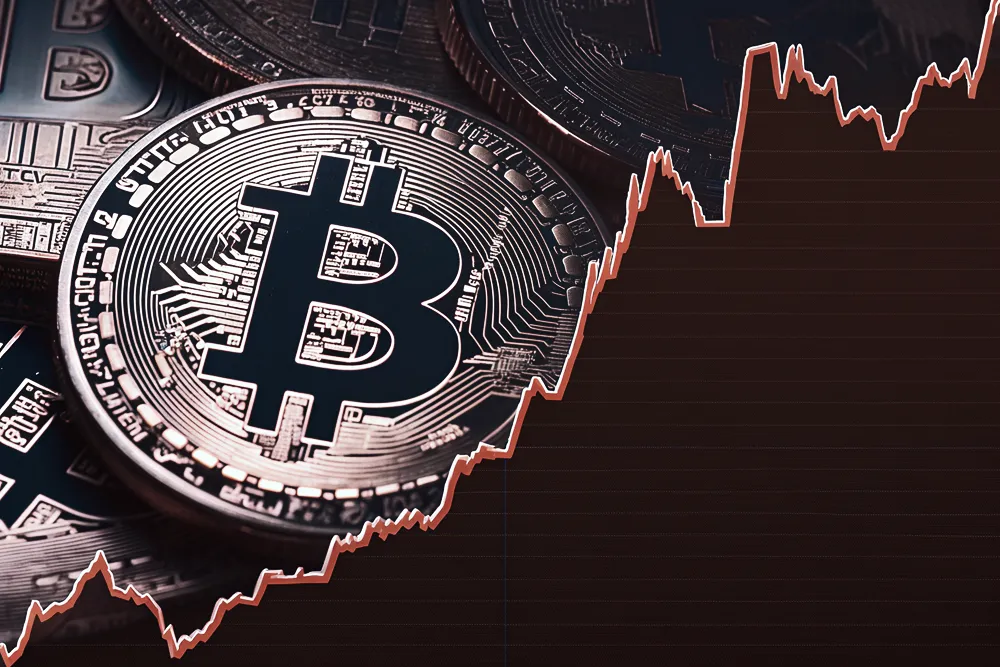Written by: arndxt
Translated by: Shan Oppa, Golden Finance
In the past few months, my stance has undergone a significant shift: from "extremely bearish to bullish" (general pessimism often lays the groundwork for a rebound) to "bearish to genuinely worried that the system is entering a more fragile stage."
This change is not due to a single event, but rather a comprehensive consideration of five mutually reinforcing trends:
The risk of policy missteps is rising. The Federal Reserve continues to tighten financial conditions against a backdrop of increasing data uncertainty and clear signs of economic slowdown.
The cluster of artificial intelligence / mega tech stocks is shifting from cash-rich to leverage-driven growth. This transforms the risk from mere stock volatility to more typical credit cycle issues.
Discrepancies in private credit and loan valuations are beginning to emerge. Beneath the surface, early warning signs of model valuation pressure have appeared, though still preliminary, they are concerning.
The K-shaped economy is solidifying as a political issue. An increasing number of people believe that the social contract is no longer trustworthy, which will ultimately be reflected in policy.
Market concentration has become a systemic and political vulnerability. When about 40% of the weight in an index is concentrated in a few tech giants sensitive to geopolitical and leverage issues, they are no longer just growth stories but targets for national security and policy regulation.
The baseline scenario may still be that policymakers will ultimately "act as usual": injecting liquidity for the next political cycle to support asset prices. However, the path to this outcome is more rugged, more credit-driven, and fraught with higher political uncertainty than the standard "buy the dip" strategy envisions.
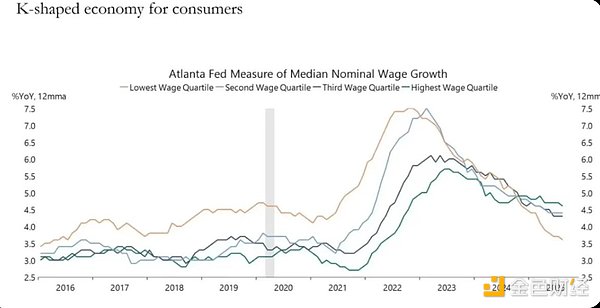
1. Macroeconomic Stance
For most of this cycle, a "bearish but constructive" stance has been reasonable:
Inflation is high but continues to decline, though the rate of decline is slowing.
Overall, policy remains supportive.
Risk asset valuations are high, but pullbacks are usually supported by liquidity.
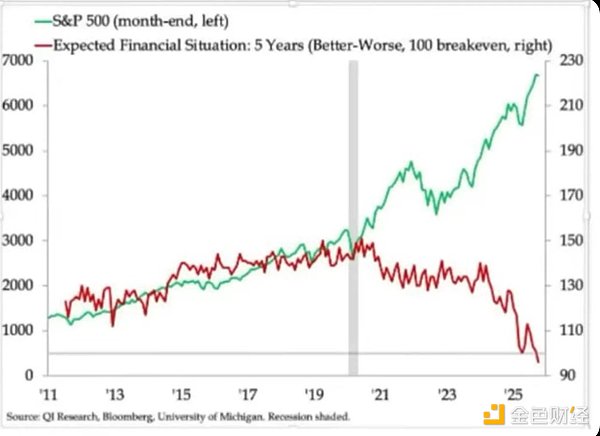
Now, several key factors have changed:
Government Shutdown: We have experienced a prolonged shutdown that disrupted the rhythm and quality of key macro data releases.
Statistical Data Uncertainty: Senior officials themselves acknowledge that federal statistical agencies have been compromised, meaning that core data series anchoring trillions of dollars in positions have seen a decline in credibility.
Hawkish Turn Amid Economic Weakness: Against this backdrop, the Federal Reserve still chooses to adopt a more hawkish stance on interest rate expectations and balance sheet policy, tightening financial conditions even as leading indicators worsen.
In other words, the system is tightening towards ambiguity and emerging pressures, rather than moving away from them. This represents a distinctly different risk landscape.
2. Policy Tightening in the Fog
The core concern is not the tightening of policy itself, but the areas and methods of tightening:
Data Fog: Key data releases (inflation, employment) have been delayed, distorted, or questioned following the shutdown. The Federal Reserve's own "dashboard" has become less reliable at the most critical moments.
Interest Rate Expectations: Although leading indicators suggest inflation will continue to decline into early next year, hawkish comments from Federal Reserve officials have led to a decrease in the market's implied probability of short-term rate cuts.
Balance Sheet: The process of quantitative tightening continues, and there is a tendency to transfer more duration risk to the private sector. Even if policy rates remain unchanged, this stance essentially still exerts hawkish pressure on financial conditions.
Historically, the Federal Reserve's missteps have often been timing errors: raising rates too late and cutting rates too late. We are at risk of repeating this pattern: tightening policy in the face of slowing growth and ambiguous data, rather than proactively easing.
3. AI and Mega Tech Stocks Become Leverage Growth Stories
The second structural shift lies in the attributes of mega tech stocks and AI leaders:
Over the past decade, the core seven tech giants have essentially been bond-like stocks: possessing dominant businesses, massive free cash flow, and limited net leverage. In the past two to three years, this free cash flow has increasingly been directed towards AI capital expenditures: data centers, chips, infrastructure. We are now entering a new phase where new AI capital expenditures are increasingly reliant on debt issuance rather than solely on internally generated cash.
The implications are as follows:
Credit spreads and credit default swaps are beginning to fluctuate. As companies like Oracle increase leverage to fund AI infrastructure, their credit spreads are widening.
Stock volatility is no longer the only risk. Industries that previously seemed "bulletproof" are beginning to exhibit typical credit cycle dynamics.
Market structure amplifies this effect. These companies hold excessive weight in major indices, and their transition from "cash cows" to "leverage growth" alters the risk profile of the entire index.
This does not automatically mean the end of an AI "bubble." If returns are real and sustainable, debt-financed capital expenditures are reasonable. However, it does mean that the margin for error has significantly narrowed, especially in an environment of high interest rates and tightening policy.
4. Early Cracks in Credit and Private Markets
Beneath the surface of the public markets, early signs of pressure are emerging in private credit: significant discrepancies in the valuation of the same loan by different managers (for example, some valuing it at 70% of face value, while others at about 90%). This divergence is a typical precursor to broader disputes between model valuations and market valuations.
This pattern resembles historical events: 2007 — an increase in bad assets, widening spreads, while stock indices remained relatively calm. 2008 — markets once viewed as cash equivalents (such as auction rate securities) suddenly froze.
Additionally, the Federal Reserve's reserves are beginning to decline. There is an increasing internal recognition that some form of balance sheet expansion may be needed to prevent issues in the functioning of the financial system.
None of this means that a crisis is inevitable. But it aligns with a system where credit is quietly tightening while policy still touts "data dependence" rather than proactive measures.
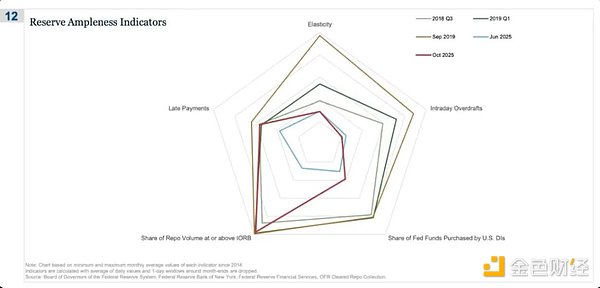
The repo market is the first signal that "reserves are no longer abundant." I recently discussed this with Zhou Shuheng.
In this radar chart, the "proportion of repo transaction volume at or above the reserve balance rate" most clearly reflects that we are quietly exiting a truly abundant reserve regime.
From Q3 2018 to early 2019, this indicator remained relatively stable: ample reserves meant that most secured financing transaction rates comfortably fell below the lower limit of the reserve balance rate.
By September 2019, just before the repo market collapse, this indicator surged, with an increasing number of repo transaction rates reaching or exceeding the reserve balance rate — a typical symptom of collateral and reserve scarcity.
Now compare June 2025 with October 2025: the light blue line (June) remains in a safe range, but the red line for October 2025 has extended outward, approaching the shape of 2019, indicating that an increasing number of repo transactions are hitting the lower limit of policy rates.
In other words, traders and banks are raising overnight financing rates because reserves are no longer abundant. Combined with other indicators (increased intraday overdrafts, rising federal funds purchases by U.S. deposit institutions, and increased late payments), a clear signal emerges: the liquidity buffer of the financial system is weakening.
5. K-shaped Economy as a Political Variable

In my view, the economic divergence we have long referred to as "K-shaped" has now become a political variable:
Household expectations are diverging. Long-term financial outlooks (such as five-year expectations) show significant gaps: some groups expect stability or improvement, while others anticipate significant deterioration.
Real-world pressure indicators are flashing: the default rate among subprime auto loan borrowers is rising. The age of first-time homebuyers is being pushed back, with the median age of first-time buyers approaching retirement age. Youth unemployment rates are slightly rising in multiple markets.
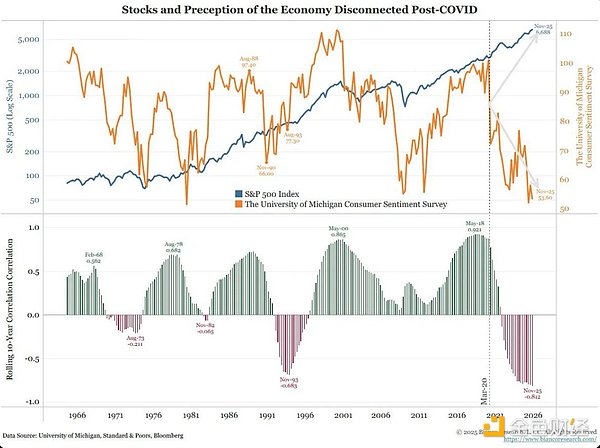
For an increasing number of people, this system is not only "unequal" but also dysfunctional: they have no assets, limited wage growth, and almost no realistic path to participate in asset inflation. The recognized social contract of "working hard, making progress, accumulating wealth and security" is disintegrating.
In this environment, political behavior is changing: voters are no longer choosing the "best managers" of the current system. They are increasingly willing to support candidates on both the left and right with destructive or extreme positions, as the downside risk seems limited to them: "things can't get worse."
Future policies regarding taxation, redistribution, regulation, and monetary support will be formulated against this backdrop. This is not neutral for the market.
6. Market Concentration as Systemic and Political Risk
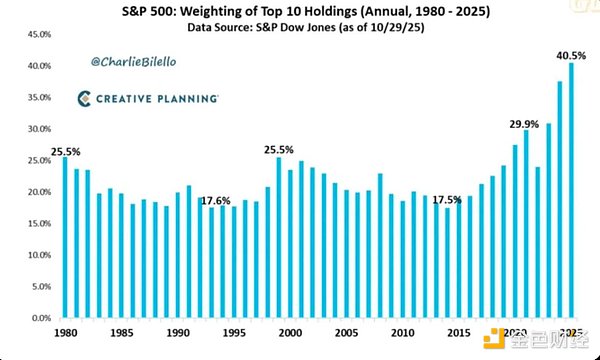
The concentration of market capitalization in a few companies has systemic and political implications that are often under-discussed: currently, the top ten companies account for about 40% of the weight in major U.S. stock indices.
These companies are core holdings in pension funds, 401(k) plans, and retail portfolios. They increasingly rely on artificial intelligence, are exposed to risks in the Chinese market, and are sensitive to interest rate paths. They effectively play monopolistic roles in several digital domains.
This raises three interwoven risks:
Systemic Market Risk: The shocks these companies face—whether from earnings, regulation, or geopolitical issues (such as the Taiwan issue or changes in Chinese demand)—will quickly transmit throughout the entire household wealth system.
National Security Risk: When a significant amount of national wealth and productivity is concentrated in a few companies with external dependencies, they become strategic vulnerabilities.
Political Risk: In the context of a K-shaped economy and the rise of populism, these companies become the most visible focal point of discontent: higher taxes, windfall taxes, buyback restrictions, and antitrust breakups. There are calls for strict regulations on artificial intelligence and data.
In other words, these companies are not only engines of growth but also potential policy targets, and this possibility is rising.
7. The Temporary Ineffectiveness of the Bitcoin, Gold, and "Perfect Hedge" Narrative
In an environment characterized by risks of policy missteps, credit pressures, and political instability, one might expect Bitcoin to thrive as a macro hedge tool. However, the reality is:
Gold exhibits the characteristics of a traditional crisis hedge: steadily strengthening, with moderate volatility, and increasing importance in investment portfolios.
Bitcoin's trading behavior resembles that of high-beta risk assets: highly correlated with liquidity cycles. It is sensitive to leverage and structured products. Early long-term holders are reducing their positions in this environment.
The initial narrative of decentralization and monetary revolution remains conceptually appealing, but in practice: the dominant flows of funds today are driven by financialization behaviors: yield strategies, derivatives, and low-volatility trading. Empirically, Bitcoin is closer to the beta coefficient of tech stocks rather than a neutral, robust hedge tool.
I still believe 2026 could be a significant turning point for Bitcoin (the next policy cycle, the next round of stimulus, and further erosion of trust in traditional assets). However, investors should recognize that at this stage, Bitcoin has not provided the hedging properties many expect; it is part of the same liquidity system we are concerned about.
8. 2026 Scenario Framework
An effective way to understand the current environment is that it represents a managed bubble contraction aimed at creating space for the next round of stimulus.
The possible sequence is as follows:
Mid-2024 to Mid-2025: Controlled tightening and stress testing. Government shutdowns and political dysfunction create cyclical drag. The Federal Reserve leans hawkish in rhetoric and balance sheet policy, tightening financial conditions. Credit spreads widen moderately; speculative areas (AI, long-duration tech stocks, some private credit) bear the initial shocks.
Late 2025 to 2026: Re-injection of liquidity under the political cycle. As inflation expectations decline and markets correct, policymakers regain "space" for easing. We will see interest rate cuts and fiscal measures to support growth and electoral goals. Due to policy lags, the consequences of inflation will manifest after key political junctures.
Post-2026: Systemic repricing. Depending on the scale and form of the next round of stimulus, we may either face: a new cycle of asset inflation accompanied by more political and regulatory interventions; or more abruptly confront issues of debt sustainability, market concentration, and the social contract.
This framework is not deterministic, but it aligns with the current incentives: politicians prioritize re-election over long-term equilibrium. The simplest tools remain liquidity injections and transfer payments rather than structural reforms. To use these tools again, they first need to squeeze parts of the current bubble.
Conclusion
Various signals point to the same conclusion: the system is entering a more fragile stage with a lower margin for error in this cycle. In fact, historical patterns suggest that policymakers will ultimately respond with significant liquidity injections.
Entering the next phase requires navigating a period marked by the following characteristics: tightening financial conditions, rising credit sensitivity, increased political volatility, and increasingly nonlinear policy responses.
免责声明:本文章仅代表作者个人观点,不代表本平台的立场和观点。本文章仅供信息分享,不构成对任何人的任何投资建议。用户与作者之间的任何争议,与本平台无关。如网页中刊载的文章或图片涉及侵权,请提供相关的权利证明和身份证明发送邮件到support@aicoin.com,本平台相关工作人员将会进行核查。
